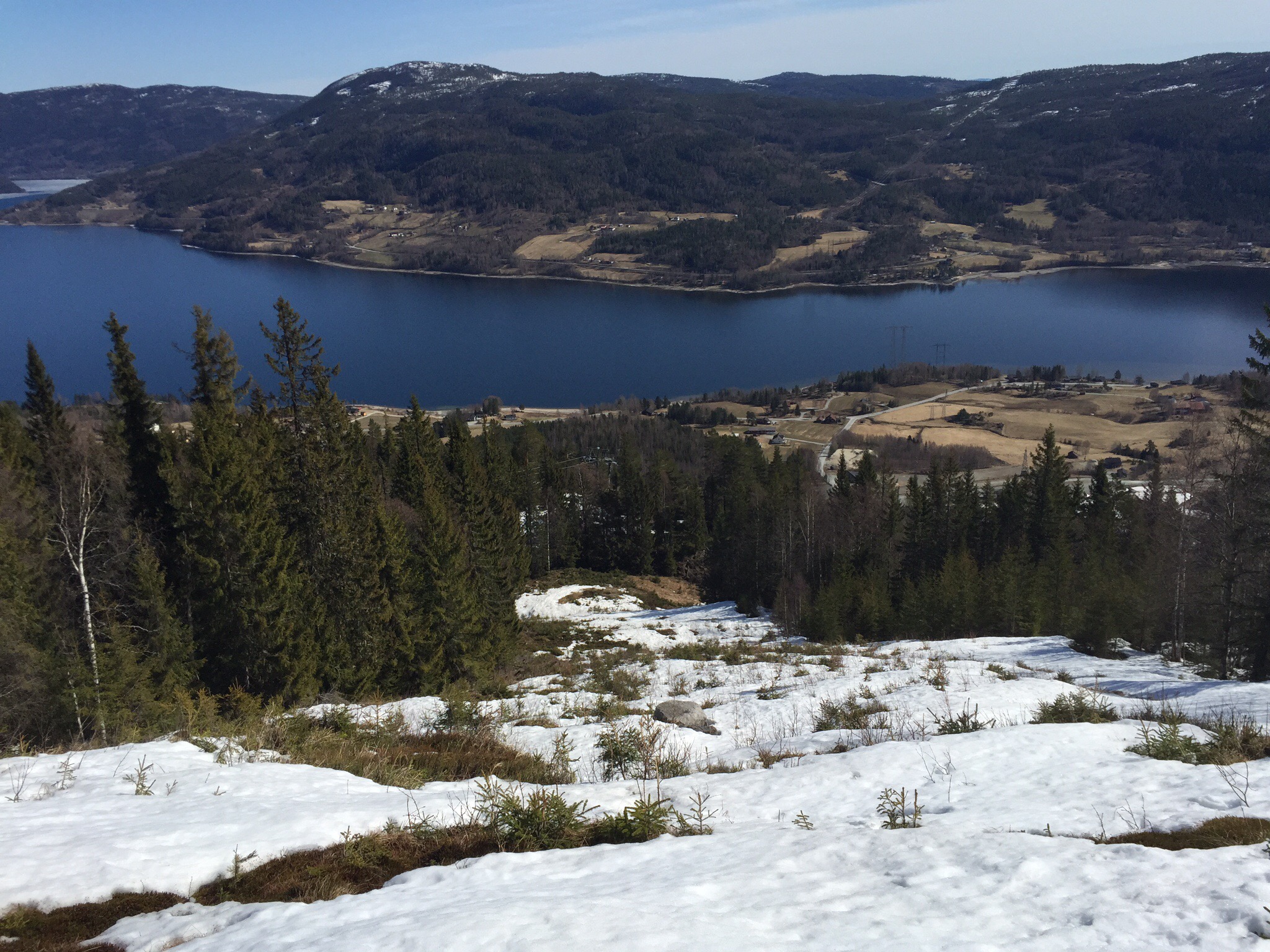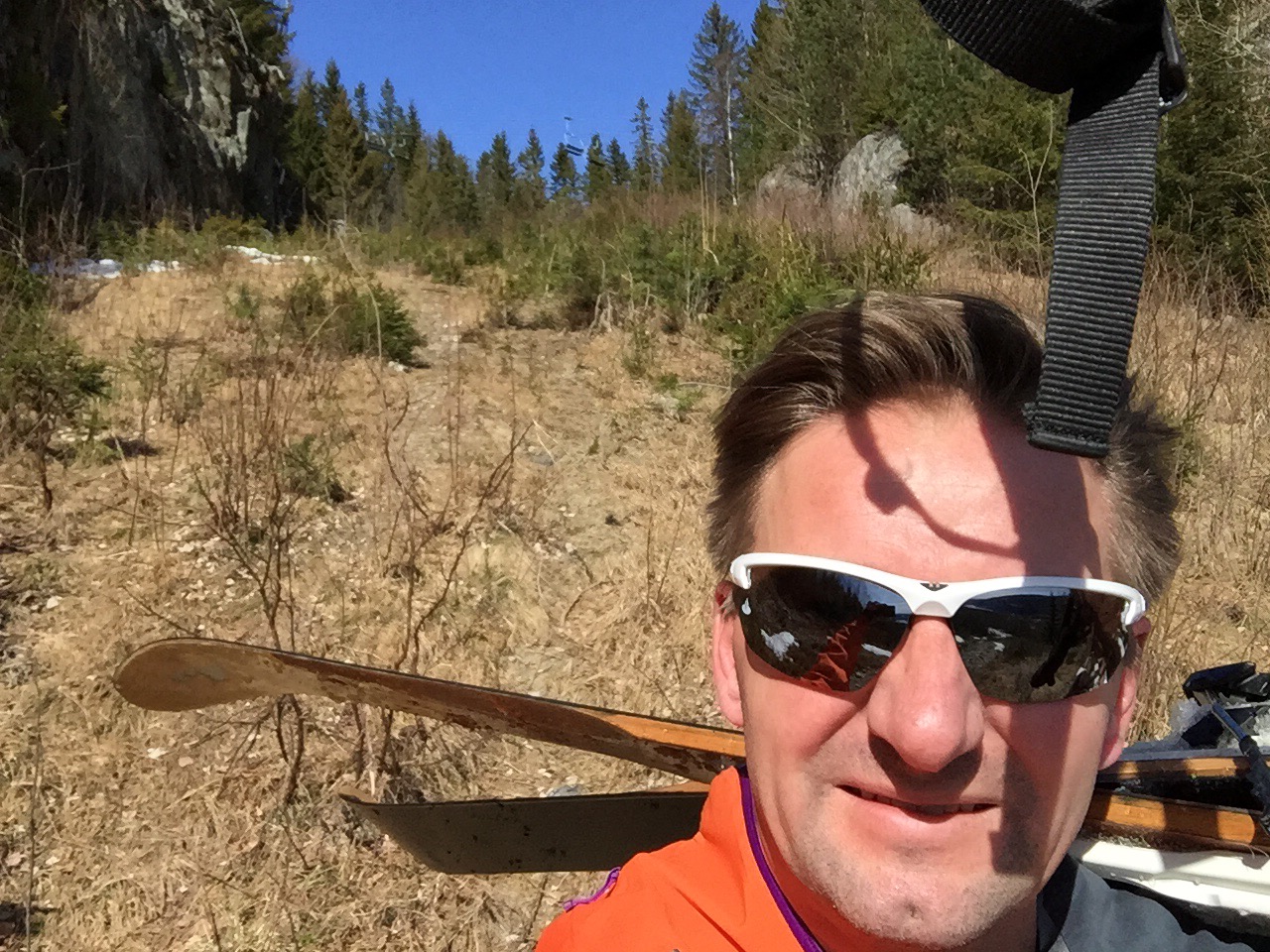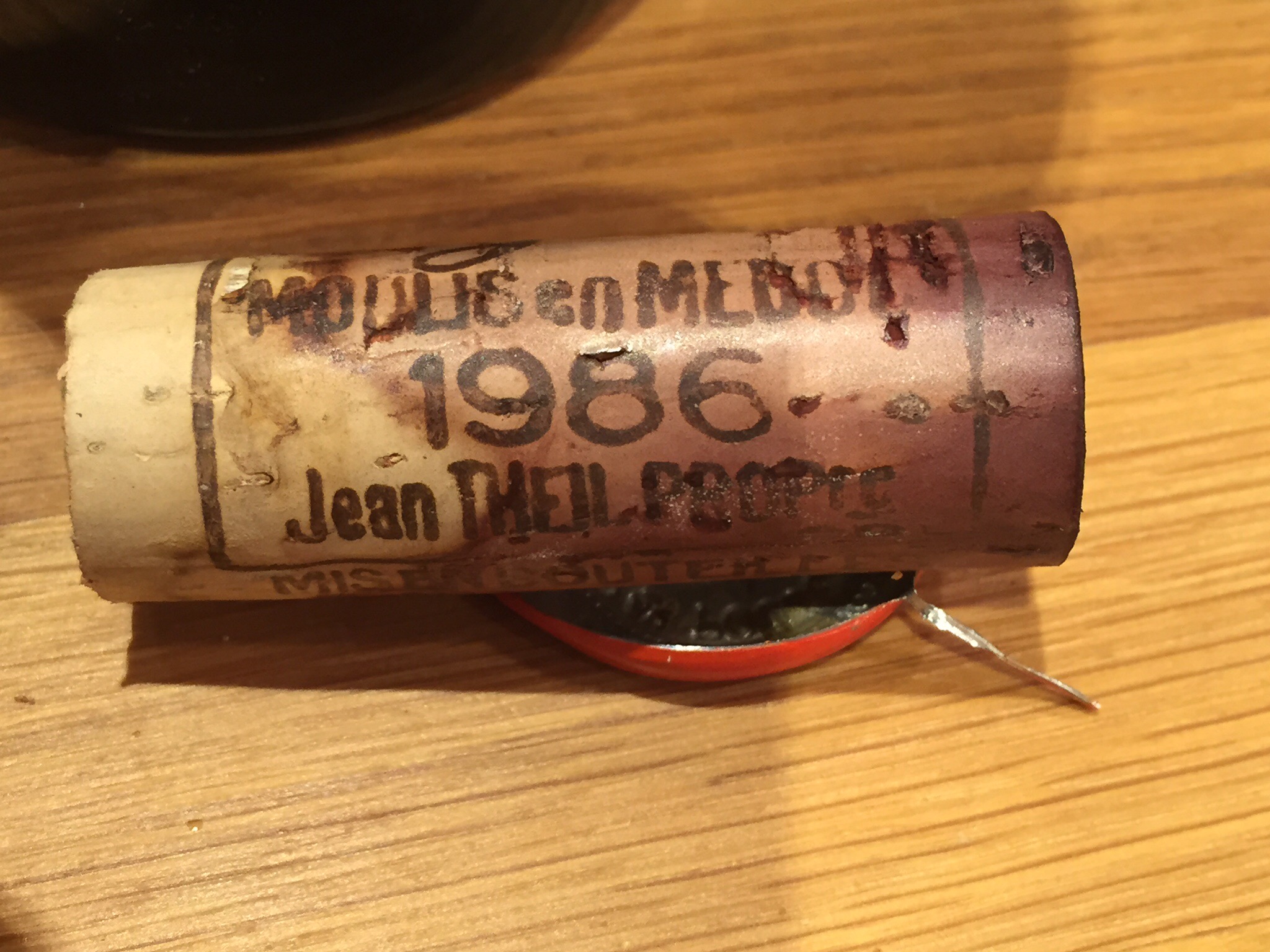0d48bedd40f4c3314167ab68ec27a560
Blog Andersen
I swear by my life and my love of it that I will never live for the sake of another man, nor ask another man to live for mine.
6f8a6b5f6bb78bcd31826864b24eb5ef
0d48bedd40f4c3314167ab68ec27a560
6f8a6b5f6bb78bcd31826864b24eb5ef
0d48bedd40f4c3314167ab68ec27a560
Norefjell stenger for sesongen 17.04.2015
Det var strålende sol, varmt i husveggen i Drøbak, blomster i beddene og på magnoliatreet. Men det var også siste weekend med heiser på Norefjell. Bilen hadde stått uten lading fra fredag morgen, men med en Supercharger på Lier så skulle dette gå greit. Sommerdekk er heller ingen hindring.
Turen opp krevde 10 minutter Superlading, samt litt lading i hytteveggen mens jeg kledde meg om, hentet ut ski og støvler. Sendte melding til Anne-Siri om lunsj, på med solbriller, av med hjelm og nøt en fantastisk parkett av en bakke. Ikke et menneske å se. Kanskje 3-4 stykker i hele t-kroken, eller 4-5 stoler i bruk i stolheisen.

Jeg så at det fortsatt lå nok med sne i den gamle utforløypen, under stolheisen. Må prøves, bare må prøves. Joda, bisken og solbaderne fikk seg et støkk da jeg suste over deres lille haveflekk på vei ned mot bedre bakker. Jeg var nok en gang helt alene. Her kjører det ikke folk lenger. Too bad. Ja, det endte opp med å gå et stykke nedover den bratte lien, men helt klart verdt turen. Jeg kjørte den likesågodt to ganger.



Så var det lunsj på Norefjellhytta. Anne-Siri og hennes danske team leverer. Dette var kanskje en av de bedre måltidene de har servert i år. Men som alltid, servicen er en katastrofe. Uoppmerksomme, lite tydelige, norske piker som overhode ikke har et service-gen i kroppen. Makan så mye bedre dette kunne vært. De har fantastisk beliggenhet, skikkelig drivkraft fra eiere, meget gode kokker, et helt supert interiør, gode viner, og akkurat passe størrelse. Det mangler kun det lille siste. Få inn noen som kan servere.

Bøseter var også bra. Jeg avsluttet ved stengetid kl. 16.20. Tilbake på hytten for å skifte og ikke minst lade det jeg kunne. Rød plugg gir rundt 55 km/t i lading. Turen hjem krevde 3 minutters lading på Superladeren igjen, for å garantere hjemkomsten. Stoppet innom Bare Mas i Drøbak og plukket opp middagen. Dagene er MYE lengre nå på våren.
God sommer.
Topptur Norefjell 21. mars 2015
Det er vårjevndøgn, gårsdagen hadde solformørkelse og endelig litt sne på toppen av skarelaget. Jeg reiste opp kl 0800 idag tidlig. Tok med bisken, litt mat om det ble overnatting, nøtteblanding og Pellegrino. Her blir det tur i solskinnet. Nydelige -5 grader, sterk sol som krever raske briller og en rask lunsj mens bilen fikk en time på den nye ladepluggen. Tre-fas røsker godt i Teslaen.
Det er dessverre ikke anledning til å parkere inne i parkeringshuset på hotellet, da det er forbeholdt overnattingsgjester. Det hadde jeg ingen planer om. Men hvor absurd er ikke det å parkere i hus når en skal gå topptur? Parkerte foran inngangen. De har helt sikkert glede av å beskue en ny Tesla P85D mens de tenker over parkeringsanleggets nye diskriminerende regler. La på skinns mens Molly-bisk beskuet det hele, med sele på, fra bagasjerommet. Minnet om full regelrytteri da Pappa var i skianlegget med løshund frister ikke. Så den lydige bisken ventet tålmodig på at matfar skulle få med seg alt rasket.

Turen opp gjennom baby-bakken, rett inn mellom trærne, over to langrennsløyper og forbi MANGE harespor gikk raskt denne gangen. Av med jakke og genser. Her er det ull-t-skjorte som teller. Bra jeg fikk på meg litt solkrem tidligere på dagen. Da Molly så alle kitene fyke frem og tilbake, kryss og tvers, opp og ned, så gikk hun stort sett på bakbenene for å få med seg det samme som redaksjonen i FriFlyt. Vi snakker fort femti kites på åsryggen. Vi dundret på, opp den bratte bakken, tok igjen noen på lette langrennski i kjent fiskebenstil. Makan til ineffektiv måte å pese opp en bakke på. Bedre smøring, eller feller i mitt tilfelle, går jo som et lokomotiv i forhold. Ikke ett glipp.
Toppen er nådd. 1340 meter over havet. En stigning på litt over 500 meter på én time. Traff på en hyggelig snowboarder med truger på toppen. Tror han brukte mer tid…. Molly og jeg nøt medbragt. Müslibrød med prim, nøtteblanding og sist men ikke minst en super salami fra Verbier. Ja, vi delte, dog ikke broderlig. Hun ble forfordelt. That’s a dogs life. Greit, innrømmer at Elisabeth lagde vesentlig bedre lunsj ifjor. Slik er det når en ikke har sine vakre svigerinner med…

Nedturen med skikkelig støvler, bindinger og ski er en opptur. Ikke noe tøys med tech-bindinger myke som smør, støvler som mokasiner og lette ski som lavet av luft eller titan. Neida, full pupp med ekte vare. Veier litt mer for smakens skyld. Virker som Molly også hadde store forventninger til nedturen. Full av vigør, bjeffing hele veien, høyre venste, høyre, venstre, i veien, bak meg på trynet, foran en farlig stålkant. Makan til uryddig løping på gjeterhunden har jeg ikke sett. Plutselig fikk hun et innfall av kite-los igjen. Spant avgårde, men lydig nok, så kom hun ved første ymting av hennes navn. Men så kom vi oss ned mellom litt buskvekster igjen. DETTE VAR GØY! For meg altså. Bedre sne, skøyeraktige småtrær her og der, vokst opp som om de ropte om en sprutsving i sitt nærvær. Molly ble helt hvit da hun “tilfeldigvis” holdt seg til skiers left, der alle høyresvingene la igjen en roostertail av sprutsne. For en tur!

Det ble “after-ski” på terrassen. Rakk det før den jævla furuen skygget. Fikk melding om at jeg kunne gjerne bli på fjellet, så ble det Campari-O.
Kim Wilde er på radioen!! But why? So 80-ies. Vel, det het faktisk Kim Wildes 80–ies show. Da bestemte jeg meg for å ta opp tilbudet fra Pappa om å prøve en av hans Médoc fra 1986. Måtte jo være eneste rigtige med Kim på radioen. Klassisk Bordeaux, passer nydelig til entrecote og pastinakk fra grillen.



Taxation
In a fully free society, taxation—or, to be exact, payment for governmental services—would be voluntary. Since the proper services of a government—the police, the armed forces, the law courts—are demonstrably needed by individual citizens and affect their interests directly, the citizens would (and should) be willing to pay for such services, as they pay for insurance.
The question of how to implement the principle of voluntary government financing—how to determine the best means of applying it in practice—is a very complex one and belongs to the field of the philosophy of law. The task of political philosophy is only to establish the nature of the principle and to demonstrate that it is practicable. The choice of a specific method of implementation is more than premature today—since the principle will be practicable only in a fully free society, a society whose government has been constitutionally reduced to its proper, basic functions.Any program of voluntary government financing has to be regarded as a goal for a distant future.
What the advocates of a fully free society have to know, at present, is only the principle by which that goal can be achieved.
The principle of voluntary government financing rests on the following premises: that the government is not the owner of the citizens’ income and, therefore, cannot hold a blank check on that income—that the nature of the proper governmental services must be constitutionally defined and delimited, leaving the government no power to enlarge the scope of its services at its own arbitrary discretion. Consequently, the principle of voluntary government financing regards the government as the servant, not the ruler, of the citizens—as an agent who must be paid for his services, not as a benefactor whose services are gratuitous, who dispenses something for nothing.
In view of what they hear from the experts, the people cannot be blamed for their ignorance and their helpless confusion. If an average housewife struggles with her incomprehensibly shrinking budget and sees a tycoon in a resplendent limousine, she might well think that just one of his diamond cuff links would solve all her problems. She has no way of knowing that if all the personal luxuries of all the tycoons were expropriated, it would not feed her family—and millions of other, similar families—for one week; and that the entire country would starve on the first morning of the week to follow . . . . How would she know it, if all the voices she hears are telling her that we must soak the rich?
No one tells her that higher taxes imposed on the rich (and the semi-rich) will not come out of their consumption expenditures, but out of their investment capital (i.e., their savings); that such taxes will mean less investment, i.e., less production, fewer jobs, higher prices for scarcer goods; and that by the time the rich have to lower their standard of living, hers will be gone, along with her savings and her husband’s job—and no power in the world (no economic power) will be able to revive the dead industries (there will be no such power left).
Pow-Wow
Pow-wow?? You don’t know what a pow-wow is? According to the dictionary it is: “a Native American social gathering or fair, usually including competitive dancing”, but it is actually much more than just the gathering and the dance. It is where families meet, where people show off their offspring, their regalia (not called costumes), their dancing and drumming abilities, and take pride in their heritage. It is where they eat native food, meet new people, buy additions to their regalia and generally have a good time. This week I took my two grandchildren Amalie 10 and Cedric 7, to a pow-wow at the Menominee Nation Reservation in Keshena in north-central Wisconsin, the only reservation in the state. I have gotten to know the reservation as my second-nephew’s wife was born and raised here. I have visited before and been introduced to some extraordinary people from the reservation. These are happy, easygoing and very friendly people. Needless to say; our blond / white hair was a distinct minority at this event. Since only the locals and the Native Americans generally know of these events, very few white people find their way here. We did indeed feel welcomed by all the people we met.
The pow-wow area consists of a large “bowl” in the forest where the dancing and drumming is in the center and people are sitting in the side slopes of the bowl watching and listening. People are moving about all the time, families and groups have their areas, and you as a visitor can move, sit and stand anywhere you want. You can even take part in the dance if you like when there is an intertribal dance being announced. Then of course there is plenty of easy car-parking right next to the event, and a “street” of food and artifacts vendors.
The music and the dance are the two central elements of the pow-wow and I think this need some explanation to understand what this, for us so unusual music and dance, is all about. As I can only convey pictures and words to you in my scribbling, you need to go elsewhere to get the sight and sound. Check it out on YouTube, search for “pow-wow”, and you will get the zest of the event. This is a good one for starters: http://www.youtube.com/watch?v=OCR2Dq8Lb38
The music consists of a team of some 8 to 16 men sitting in a circle around a large drum, each holding one drumstick that looks more like a club or a small bat. The pace is a constant beat with variations in the strength of the stroke and the number of drumsticks being used. The song sounds initially as just high-pitched shrieks without meaning or melody, but as you hear different teams play and get used to the sound, you understand that there is a very precise and intentional song that has been rehearsed and is different from team to team and song to song. The precision of the beat and tune of the song amongst the men is astonishing and actually rather beautiful. After a while the beat and the sound pulls you in, it enchants you, you inadvertently follow the beat and enjoy the sound and tone, however foreign it is to our European ears. Another sampler: http://www.youtube.com/watch?v=Ib1WC43g0Zs
There are many such teams and their drumming, song and proficiency are judged and rewarded in cash for each song being played. The price money for the drums and the dancers can be from $20 into many thousands of dollars. At our pow-wow there were over 20 drum teams from around the central part of the USA. Holding a microphone over the drums, you could hear the drums and the song over loudspeakers all over the pow-wow area, which again gave the event its mystical and enchanting atmosphere.
Before we get to the dance, we need to look at the clothing, regalia, decorations and equipment being worn by the dancers. Men, women, children and even babies were dressed traditional, and not two of them the same. The variety in the costumes being used is broader than any such event I have ever seen anywhere in the world. They are exceptionally colorful, detailed, intricate, expensive and full of fantasy, but never gaudy or distasteful. Women as well as men are elaborately dressed and you are never in doubt that this is Native America, and like no place else. The feathers, the beads, the little twinkling bells, the moccasins and the use of soft deerskin tell their story.
The men are impressive, the women are beautiful; a beauty beyond the dress and the person, a beauty of a complete picture of pride, culture, elaborate preparations, and in happiness and balance of whom they are. This part alone was worth the long journey here.
The grand opening is a parade of all participants in the circle in the bowl, drums playing, the sight and sound is overwhelming. The dancing is divided into age groups, men and women, traditional, fancy, jingle dress, grass, straight, intertribal, and in various other categories. Usually some 10 to 20 people participated in each dance when one drum team played. The dancers are given price money, sometimes a rather substantial amount. The dance follows the rhythm of the drums in an exact pace, the steps are small and sometimes the persons stands on the same place during the dance, other times the dancers moves in a grand circle or they move their arms and legs wildly, never loosing the pace of the drums. As the beat and the song pulls you in, so does the dance after having seen a few variations. We stayed a full 4 hours at the event, watching, seeing, hearing, living all we could – and loving it.
The main food sold is “Indian Taco” – a soft deep-fried bread-like thing with “stuff” on it. Quite good actually. Then there is corn on the cob, various other deep-fried bread or “frybread” and frozen drinks. Nothing really to rave about, but very good and interesting nevertheless.
Much more can be said of pow-wow’s, the Menominee Nation and Native Americans in general, and much more probably should be said as well. The treatment of the native peoples of America, the repeated betrayal of agreements, and the history over the past few hundred years deserves infinitely more space, words and attention than I can bring to you in a few pages of my scribbling. You can learn more about the Menominee Nation and its wonderful people on: www.menominee-nsn.gov
Svein Andersen – 4. August 2013
The first test entry
Finally I got to start the first blog entry. Sitting in the cosy environment of Drøbak with a view on a rainy warm January day without snow! Not usual at all for this time of the year, but I guess we have to get used to it as “English” weather is predicted for the next years in southern Norway.
Atlas Shrugged – For adults only
The first thing I read by Rand was Capitalism: The Unknown Ideal.
– – –
THIS ARTICLE REPURPOSED FROM: http://lamrot-hakol.blogspot.com/2012/10…
– – –
The other day, I was talking to my partner about Atlas Shrugged at the dinner table, and my 12 year old daughter asked what it was. I told her it’s a book by Ayn Rand, and that she can’t read it until she’s 21.
My partner stared at me and asked why. After all, I’m an Objectivist. I think Rand’s philosophy is incredibly important. So why would I bar my daughter from reading it until she’s an adult?
I’ve felt this way for at least a decade, but given the President’s comments about Ayn Rand’s books being something you’d pick up as a 17-18 year old feeling misunderstood, and then get rid of once you realized that thinking only about yourself wasn’t enough, I thought it would be worthwhile to explain why kids shouldn’t read Atlas Shrugged.
The thing is, Obama is right. In a way. Let me explain that.
I didn’t read Atlas Shrugged until I was 33 years old. In fact, other than Anthem, which I may have read in passing in high school, I never read anything of Rand’s until I was 32, and I started with her essays. Maybe I’ll post about how and why I got into those at a later date. But as someone who didn’t get into Rand’s philosophy as a kid, it took me a while to realize that for the vast majority of people, reading it as a teenager is almost inevitably going to create the opposite effect that Rand had in mind.
There’s a common misconception that Objectivism is about being selfish and grasping and greedy. It’s an understandable misunderstanding. After all, Rand wrote a book of essays called The Virtue of Selfishness. She spoke against altruism and in favor of selfishness. The thing is, though, that in Rand’s writing, those are “terms of art”. A term of art, or jargon, is a word that’s used a specific way in a specific field, regardless of how it’s used colloquially. In politics, to “depose” means to remove a leader. In law, to “depose” means to have someone give a deposition. In medicine, an “ugly” infection is one that doesn’t respond well to antibiotics.
We’re all familiar with groups “reclaiming” perogative words. “Queer” was an insult when I was growing up, and it still is for a lot of people. Yet to the younger generation of GLBT teens, “queer” is simply how they identify. Rand used the term “selfish” to mean acting to further ones long term and global well being, given the understanding that we are not alone in the world, and that what I do to others can be done to me as well. There is no other way to describe that in a single world, so far as I’m aware, than selfishness. Or if we allow a modifier, “rational selfishness”.
But Rand failed. She failed to communicate this in a way that would be clear enough to get past the negative connotations of selfishness as meaning a blind, grasping devotion to ones short term desires, paying no attention to the world around us. Even expanding the term to “rational selfishness” didn’t work, because people understood “rational” to mean “cold and unemotional” and concluded that “rational selfishness” meant cold, hard, unemotional, uncaring selfishness. Like a robot that lacks all empathy.
But adolescents are a different story. Adolescence is a time when we are detaching ourselves from our role as dependent children, and learning to stand on our own, personally empowered. When I was 17, I remember one evening during an argument with my father, exclaiming, “You’re a person, and I’m a person. Why should you have any more right to decide than I do!” And I was absolutely convinced of my righteousness. Two years later, when my younger brother was 17, I heard him say virtually the exact same thing. I looked at my father and said, “I’m so sorry, Dad. And I wish there was some way I could explain it to him.” But I knew there wasn’t. You can’t explain that to an adolescent. They have to learn to grow up and realize that the world doesn’t revolve around them.
Which is one of the reasons why a lot of adolescents love Atlas Shrugged. They miss the bigger picture, and only pick up on the message that they shouldn’t have to sacrifice themselves for others. Which is a good message, but they conflate it with their irrational selfishness. Their self-centered, almost solipsistic view of the world. And when they do grow up, as most of them do, they jettison Objectivism, thinking that it’s part and parcel of the adolescent mindset they no longer need.
And that’s why Obama said what he did. It’s absolutely true that 17 and 18 year olds who are feeling misunderstood, and whose self is feeling threatened would pick up Atlas Shrugged and see it as a vindication of what they’re feeling. And it’s absolutely true that someone like that reading the book would, in the vast majority of cases, throw it away once they grow up and realize that we’re all in this together, so to speak.
And that’s why I won’t let my daughter read the book. Because it takes a certain amount of maturity to understand that the kind of altruism that says doing for others is always more moral than doing for oneself is evil and anti-human, but that benevolence and empathy are vitally important virtues. The vice of altruism always leads to bad results in the long run, even if it may seem beneficial in the short term. Because giving requires a recipient. And if receiving is a bad thing, there’s always going to be someone bad and wretched. More than that, you’re always going to need poor people, because without them, you can never be virtuous. It’s an ugly world that raises altruism up as the highest virtue.
Perhaps we need to find another term to reflect what Rand called “selfishness”. The battle to reclaim that word was lost before it even started. All it does now is feed into the ignorance of the left.
Copyright © 2024. Powered by WordPress & Romangie Theme.



Recent Comments